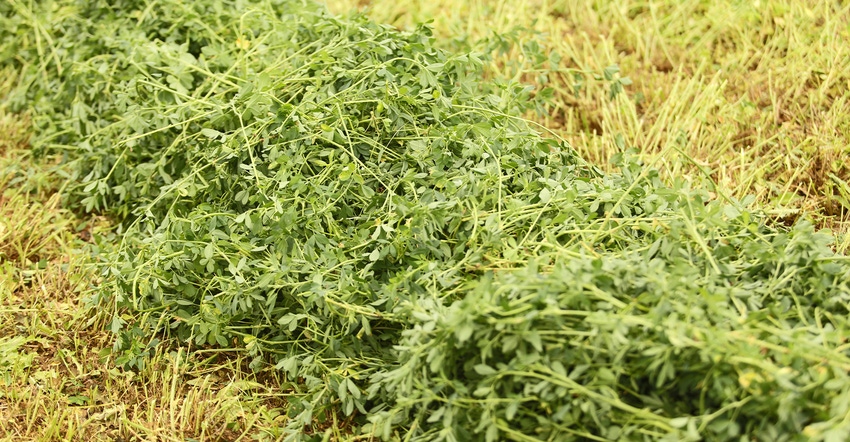May 16, 2019

Planting alfalfa in Minnesota in late summer 2019 can provide a crop with a well-developed root system that’s ready to harvest in early June 2020.
Planting date, planting depth, moisture management and weed control are all important considerations.
Here are some tips for growing a successful late-summer-seeded alfalfa crop.
1. Test soil pH. This must happen before you plant. Alfalfa does best with a neutral soil pH of 6.8 to 7. If your soil doesn’t fall within that range this year, you’ll need to apply lime to help correct the problem and then test again next spring.
If the pH is within the correct range at that time, you can plant alfalfa in late summer 2020. Also test potash levels — 150 parts per million is the minimum desired. For phosphorous, the minimum is 25 ppm.
2. Plant a cereal crop first. Planting alfalfa after corn or soybeans is unlikely to give plants enough time to establish. Alfalfa needs six to eight weeks, or about 8 to 10 inches of growth, prior to a hard frost going through a process called contractile growth. This is where the plant forms a crown and transitions from being an annual to a perennial.
Failing to achieve that growth makes it less likely that plants will survive the winter. A cereal crop like wheat, oats, rye or triticale can be harvested in July or August, generally giving you enough time to plant late-summer alfalfa.
3. Plant at the optimal time. The ideal time to plant late-summer alfalfa is between July 30 and Aug. 15. In the St. Cloud area, aim for July 30; around Rochester, Aug. 15.
Planting later than this will risk not giving plants adequate time to establish before winter.
4. Plant at the correct depth. Be sure to plant your alfalfa three-quarters of an inch below the soil surface. I recommend using a drill over an airflow system or broadcast seeding method, since a drill tends to result in more accurate seed depth control. Prior to establishment, apply potash if needed.
If your ground isn’t irrigated, receiving one good rainfall of an inch or more fairly early is important to getting alfalfa plants established. Ideally, you’ll have 25 to 30 established plants per square foot.
5. Control weeds. Weeds need to be controlled in the fall because if they’re present during establishment, they’ll take any rainfall you do receive away from your alfalfa.
Spraying glyphosate on Roundup Ready alfalfa can help you achieve good weed control without crop injury.
6. Be mindful of your tillage method. Do the minimum amount of tillage required to provide optimal seed-to-soil contact, preserve moisture and remove weeds. I recommend a light tillage procedure that doesn’t loosen the soil any deeper than necessary (no chisel plowing).
7. Avoid herbicide carryover. If you sprayed a broadleaf herbicide on your cereal crop that has carryover potential to alfalfa, use caution. Read the herbicide label so you know the carryover time period.
Herbicide carryover can last anywhere from nine to 24 months, so be aware of the chemistry that you’ve used on your previous crop before you plant alfalfa. Work with your agronomist to help you decide if it’s safe to plant, and plan accordingly.
All these steps build upon each other. If you plant seeds at the proper depth, receive adequate moisture, plant on time and control weeds, you greatly improve your chances of having a successful alfalfa stand this fall that you can harvest next spring.
Welch is a national CROPLAN® alfalfa agronomist with WinField United. Contact him at [email protected].
You May Also Like




